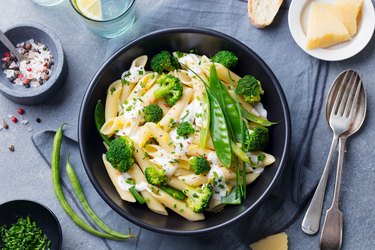
Tracking carbohydrates can help you keep your blood sugar balanced. There are a significant amount of carbs in pasta. Counting carbohydrates isn't hard, but it does take a little time and can get tricky with pasta due to different sizes, shapes and ingredients.
Video of the Day
Video of the Day
Counting Carbs in Pasta 101
Before you begin counting, decide how many carbs you'll consume at every meal and snack, as recommended by the Joslin Diabetes Center. Having an intake goal is the only way to know whether the carbs you count fall short, exceed or meet the amount you should consume. If you have diabetes consult your health care provider or dietitian to set carb goals.
Others can use the National Academies of Sciences recommendations to get 45 to 65 percent of their daily calories from carbs. Next, determine your serving size and check the nutrition facts label for the number of carbs in pasta and other items you plan to eat or drink. Add them together for each meal to see if they match your goal.
Precise Pasta Portions
The only way to be precise about your portion is to measure the pasta. You can do this after the pasta is cooked or, if you don't want to cook more pasta than you need, you can also measure the dry pasta before tossing it into the cooking water.
Some brands put the amount of dry pasta to yield the cooked serving size on the nutrition label. As a general guideline, 1/2 cup of dry elbows or rotini yields about 1 cup cooked. About 2 inches around the outer circumference of a handful of spaghetti or other long-shaped pasta becomes 1 cup when it's cooked.
Carbs per Serving
Serving sizes stated on the nutrition label range from 1 cup to 1.5 cups of cooked pasta. Since the carbs reported are for the serving size defined on the label, you may need to adjust them if you consume a different portion. Also be aware that the amounts of pasta enjoyed at a meal are often much larger than the 1/2 cup serving size on the label.
Expect 1/2 cup of cooked pasta to have 18 to 22 grams of total carbohydrates, depending on the brand and ingredients. For example, 1/2 cup of whole-wheat spaghetti has 18 grams, while the same portion of plain spaghetti has 22 grams, according to the USDA.
Read more: List of Good Carbohydrates to Eat
Which Carbs to Count
The nutrition panel reports the amount of total carbohydrates, sugar and fiber. Some products also carry statements about net carbs or effective carbs. Net carbs are calculated by subtracting dietary fiber and sugar alcohols from the total carbohydrates.
However, sugar alcohols and some types of fiber have a small impact on blood sugar and should not be ignored, according to a report from Kansas State University Nutrition News. You can subtract insoluble fiber from the total carbs if it's reported on the label, otherwise the American Diabetic Association recommends using the amount of total carbohydrates.
- Joslin Diabetes Center: "Carbohydrate Counting 101"
- USDA FoodData Central: "Spaghetti, Protein Fortified, Cooked, Enriched"
- USDA FoodData Central: "Spaghetti, Whole Wheat, Cooked"
- Kansas State University Nutrition News: "Net Carbs, Impact Carbs, Zero Carbs That Count – What Does It Mean?"
- National Academies of Sciences: "Macronutrients"
- Mueller’s: Spaghetti
- Mueller's: Corkscrews